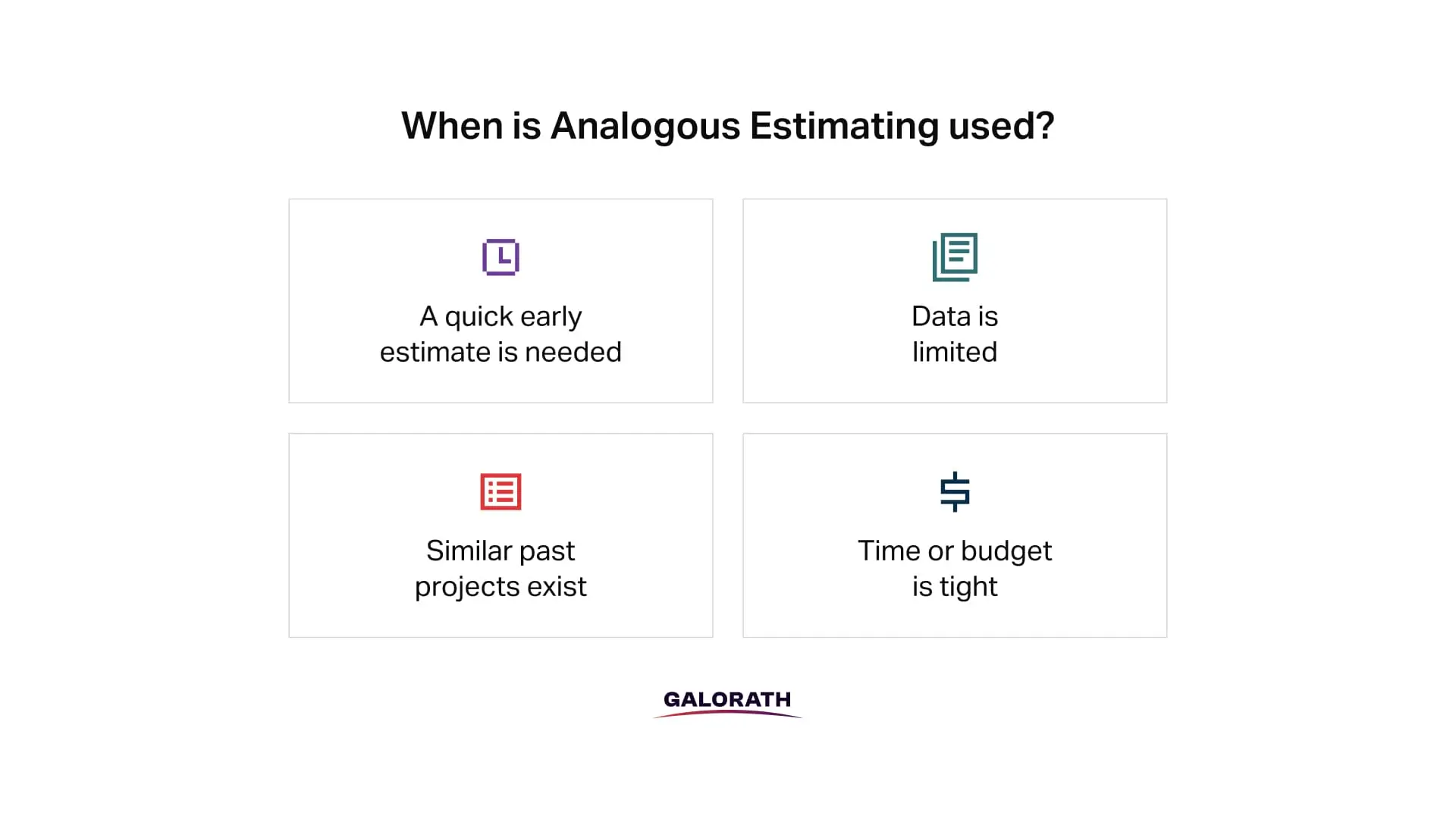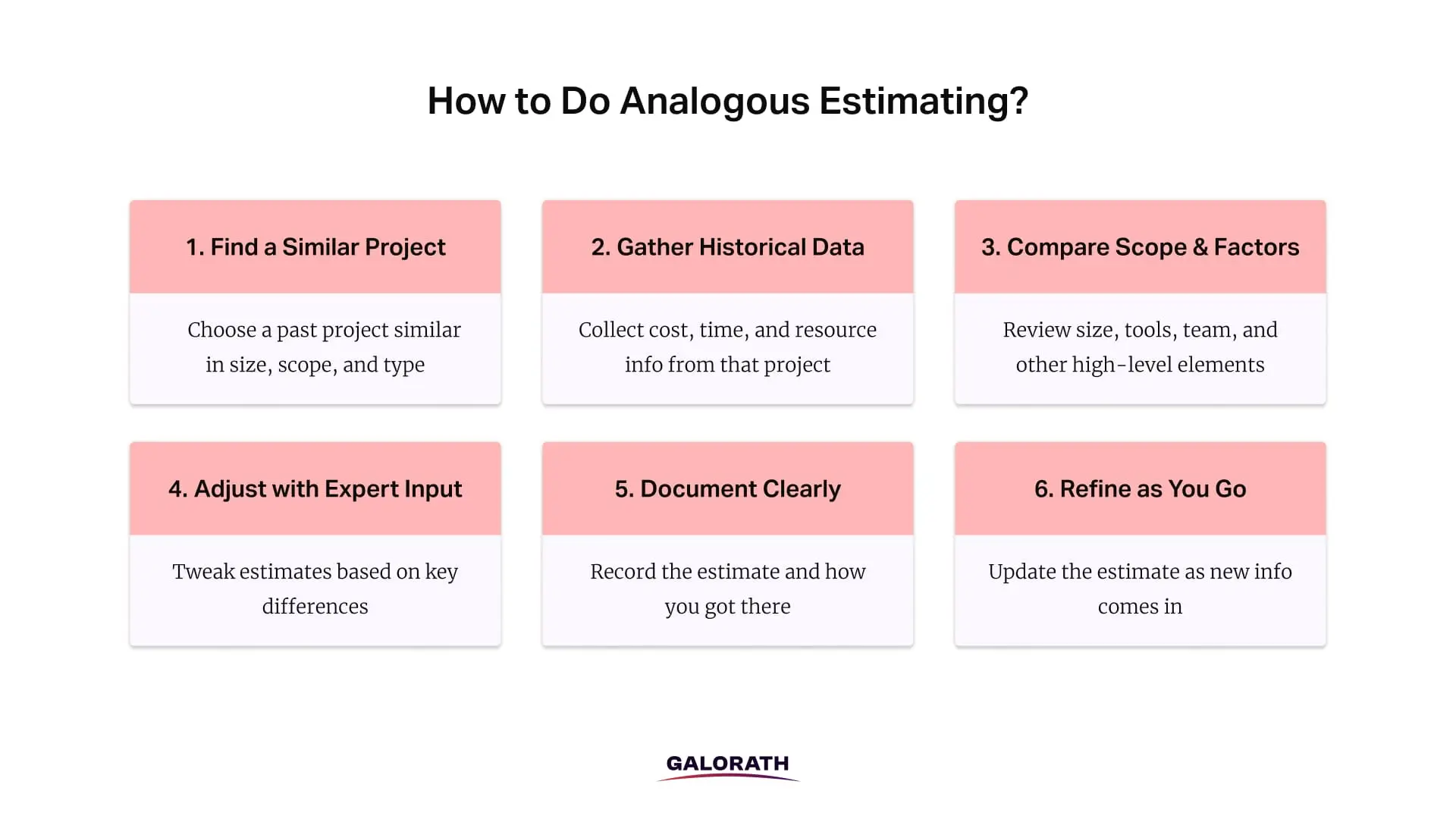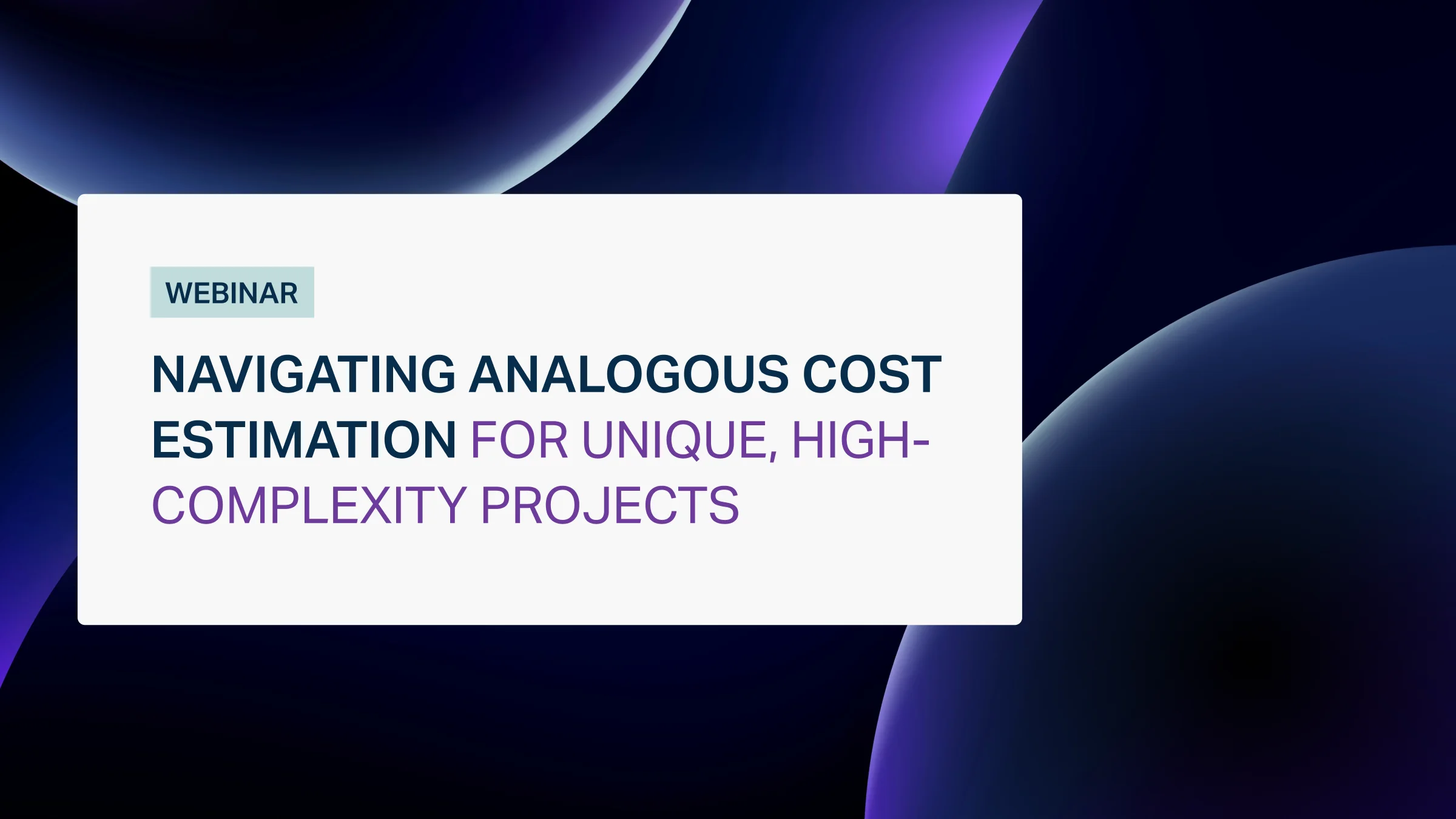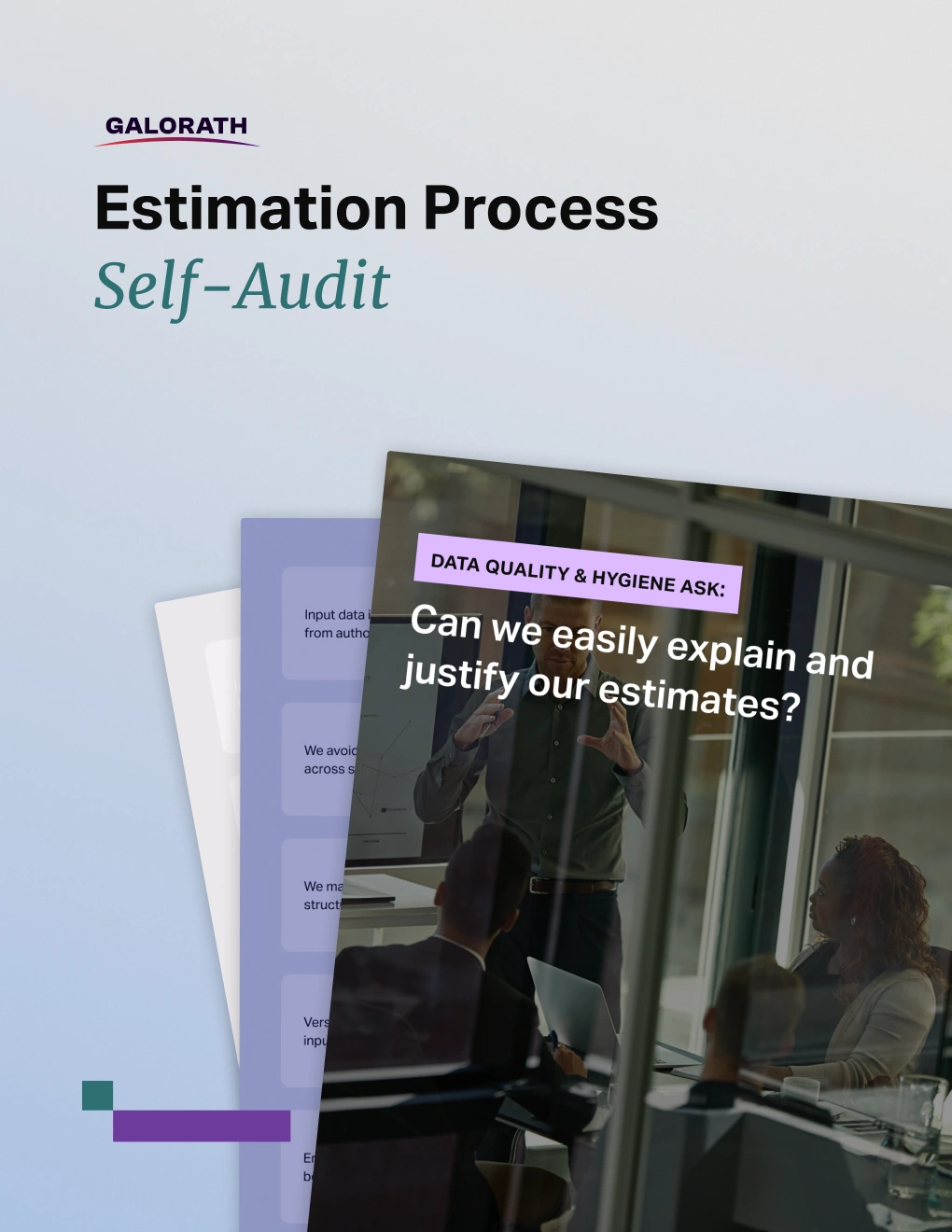Mastering Cost Risk with the CRED Model: A New Approach to Managing Uncertainty
Analogous estimating is a fast way to guess a project’s cost, schedule, or resources. It uses historical data from similar past projects to create a rough order of magnitude (ROM) estimate. Teams often use it in the early planning phase when they have limited available data.
Project managers first look at the size, scope, and time of old projects, and then they compare those to the new project in the plan. Expert judgment is used as an additional estimating layer to decide if the match is close enough. All this together helps project managers and estimators make quick and rough analogous estimates.
Analogous estimating, at its core, is part of the top-down estimating technique. This means that analogous estimating starts with the full project and scope, after which it is broken into smaller parts.
There are different types of analogous estimates. These include the single point estimates, three-point estimates, ratio estimates, and estimate ranges. Each one works best in different situations.
Generally, analogous estimating is fast and easy, but that also means it can be less accurate. If the old project is not a good match and the parameters taken are different, the estimate may be off. Relying too much on expert opinion for adjustments can also cause cognitive bias.
In this article, you will learn how teams use analogous estimating to make early project estimates, when to use analogous estimating, how analogous estimating compares to top-down and parametric estimating, what types of analogous estimation exist, and how to make analogous estimating more accurate using tools and data.
What is Analogous Estimating?
Analogous estimating is a technique that uses data from similar past projects to estimate a new project’s cost, duration, or resources. It helps create a rough order of magnitude (ROM) estimate, and it is often used in the early stages of a project.
The Project Management Institute (PMI) defines it as an estimating method that uses parameters from a previous, similar project to estimate the same parameters for the current one.
Analogous estimating relies heavily on historical data and expert judgment. Estimators examine comparable data such as time, budget, and scope from earlier efforts and projects, adjusting it to match the current project based on similarities.

How Does Analogous Estimating Work?
Analogous estimating works by comparing the current project to similar past projects and using their data to estimate cost, duration, or resources. Teams begin by identifying a completed project with similar scope, size, and complexity. They then use that project’s historical data as a reference point.
To apply this method effectively, teams rely on high-level scope and parameters. Instead of breaking down every task in detail, they look at big-picture elements like total project hours, overall budget, or delivery time. This top-level view helps them produce quick and practical estimates when time or information is limited.
Expert judgment is also a critical addition to analogous estimations. Project managers and team leads evaluate how closely the old project matches the current one. They adjust the figures based on differences in technology, team experience, location, or complexity. As one IEEE study observes: “The success of analogy-based estimation depends more on the quality of expert judgment than on the estimation algorithm itself.”
The process works best when the reference project is truly comparable. The more aligned the project similarities, the more accurate the new estimate. Without good historical matches or strong expertise, the estimate may be misleading.
When to Use Analogous Estimating?
Analogous estimating is mostly used during the early stages of a project, in the project initiation phase and the early planning phase, when detailed information is not yet available. At this point, teams need quick estimates to support crucial project decisions.
Analogous estimating is most suitable when teams have access to similar past projects. The more closely these past efforts match the new project’s scope, size, or complexity, the more reliable the estimate will be. It works best when you can identify project similarities with confidence.
This method is ideal for budget-sensitive or time-constrained scenarios. It allows project teams to create fast, high-level estimates without needing full task breakdowns. This makes it valuable in industries like software development, construction, or public sector projects-especially when clients or stakeholders demand early figures.

Use analogous estimating when:
- You need to produce an early estimate quickly
- You have limited available data
- You can base estimates on comparable data from past projects
- You are working under tight time or budget constraints
How Is Analogous Estimating Used in Project Management?
Project managers use analogous estimating to make early predictions about a project’s cost, scope, and time. This helps them plan, allocate resources, and get approval before all project details are known.
For cost, teams use data from similar past projects to estimate how much the current project will require. This provides a quick view of the budget, especially during the early planning phase, when only high-level numbers are needed.
For scope, project managers look at the project similarities in features, size, and deliverables. This helps define what the new project will include without needing a full breakdown of every task.
For time, teams use historical data to estimate how long the project might take. They compare overall duration, key milestones, and effort from previous projects. This supports fast timeline planning when full schedules are not yet available.
In all three cases, analogous estimating relies on expert judgment and comparable data. It is especially useful when managers need to build stakeholder confidence early or when making go/no-go decisions with limited available data.
Who Uses Analogous Estimation?
Project managers are the primary users of analogous estimating. Analogous estimating helps them guide planning, budgeting, and stakeholder communication during the project initiation phase.
Cost estimators also use analogous estimating to generate quick forecasts based on historical data from similar past projects. They rely on this method to support bidding, budget proposals, and financial planning-especially in time-constrained scenarios.
Program managers and portfolio managers apply it when comparing multiple projects. They use it to decide which projects are feasible or worth pursuing, especially when they need to evaluate options early with limited available data.
Senior stakeholders and executives may request analogous estimates to support decision-making during strategic planning. These estimates offer a fast way to judge whether a project fits the organization’s goals and constraints.
All these roles depend on expert judgment and comparable data to make the estimates meaningful and actionable.
Relationship Between Analogous and Top-Down Estimating
Top-down estimating is an approach where teams start with the total project scope or overall deliverables, then break it down into smaller parts. This strategy works well in the early stages of a project, especially when detailed task-level data is not yet available.
In project management, many people use analogous estimating and top-down estimating interchangeably. This is common in PM frameworks like PMI and PRINCE2. However, it is important to know the difference. Top-down refers to the estimation structure-starting from the top level of the work breakdown structure (WBS), while analogous estimating is one specific method used within that structure.
Difference Between Analogous and Parametric Estimating
Analogous estimating and parametric estimating are both widely used as project estimation techniques, but they differ in how they generate estimates.
As explained, analogous estimating uses historical data from similar past projects. Project teams apply high-level comparisons and rely on expert judgment to adjust for differences. However, it can be less accurate if the past projects are not truly comparable.
Parametric estimating, on the other hand, uses statistical or mathematical models. Teams identify variables like cost per square meter or hours per feature and apply these to the new project based on actual units. This method needs detailed, reliable data and often works best when tasks are repetitive and measurable. It tends to be more accurate, but also requires more time and data to apply.
Let’s compare this in a simple table:
| Feature | Analogous Estimating | Parametric Estimating |
| Based on | Similar past projects | Mathematical models and unit-based formulas |
| Data type | Historical data, high-level | Detailed, quantifiable data |
| Speed | Fast | Slower |
| Accuracy | Lower, depends on project similarities | Higher, if input data is reliable |
| Data requirement | Works with limited available data | Needs large and specific datasets |
| Use case | Early stages of a project, quick estimates | Detailed planning with repeatable elements |
| Depends on | Expert judgment | Data-driven analysis |
Project managers often choose between these methods based on the project’s timeline, available data, and level of detail required. In some cases, they use both techniques together to balance speed and accuracy.
What are the 4 types of Analogous Estimates?
There are 4 types of analogous estimates that project managers use, absolute or one point estimates, three-point estimates, ratio estimates and estimated ranges. Each of these are used depending on how much historical data is available and how accurate the estimate should be. Each type uses historical data from similar past projects, but the way the data is applied can vary.
Absolute or One-Point Estimate
A single point estimate gives one specific value for the cost, duration, or resources needed. Project teams create it by comparing the current project directly to a past project with similar scope and applying the same or slightly adjusted figures. This method is simple and fast, but it can be less accurate because it does not account for uncertainty or variability.
Three-Point Estimate
Even though it is defined as a separate project estimating technique, the three-point estimate improves analogous accuracy by including a range of outcomes. It uses three values: the optimistic, pessimistic, and most likely estimate. Teams additionally apply expert judgment to assess each point, then average them using formulas like the PERT method. This type works well when there is some uncertainty and when the team needs to show possible risks or delays.
Ratio Estimate
A ratio estimate describes the relative application of cost or effort based on a fixed ratio. For example, a team may estimate the new project will cost 80% of a previous one due to fewer features or reduced scope. This type is useful when the team can easily measure differences between projects and apply a consistent adjustment.
Estimated Range
An estimate range provides a minimum and maximum value. This type is helpful when teams expect variation and want to avoid misleading precision. It shows a range of possible values rather than a single number. Stakeholders often prefer this when working with limited data or in early planning phases.
Each of these estimate types supports different planning needs. Choosing the right one depends on data quality, project complexity, and how much risk or uncertainty the team needs to account for.
5 Advantages of Analogous Estimating for Project Estimating
Analogous estimating offers several key benefits that make it a popular choice during the early stages of a project. It helps teams make fast, informed decisions when detailed data is not yet available.
1. Quick Estimation
Analogous estimating allows project teams to produce an early estimate rapidly. Since it uses historical data and broad comparisons, teams can avoid time-consuming breakdowns and deliver estimates faster. This supports faster approvals and initial planning.
2. Low Cost and Minimal Effort
Because it does not require detailed task-level data, this method saves time and money. Teams can use comparable data from similar past projects to generate estimates without extensive data gathering.
3. Useful with Limited Data
This technique works well when teams have limited available data. It allows them to move forward even when project details are unclear, making it valuable during project initiation or when requirements are still forming.
4. Supports Early Decision-Making
By providing a rough order of magnitude (ROM) estimate, analogous estimating helps managers assess project feasibility, set initial budgets, and communicate timelines to stakeholders. This builds stakeholder confidence in the early planning phase.
5. Easy to Apply
Teams can apply analogous estimating using basic tools like spreadsheets or project management software. As long as they have access to relevant historical data and some expert judgment, they can get started without complex models.
Limitations and Challenges of Analogous Estimating
Analogous estimating has a lot of advantages and can be very useful during the early stages of a project, but it comes with several built-in risks and limitations. All these can lead to unreliable estimates if not carefully managed.
1. Lower Accuracy (High Uncertainty)
Because analogous estimating relies on high-level scope and past data, it can be less accurate. If there are differences in complexity, technology, or team performance between projects, the estimates may not reflect real effort or cost. This makes the method less reliable for detailed planning.
2. Requires a Truly Comparable Project
The quality of the estimate depends on choosing a similar past project. If the reference project differs in scope, scale, or environment, the estimate will be flawed. Teams must carefully identify project similarities and confirm that the historical data used is valid.
3. Overlooking Unique Characteristics
Each project has unique risks, goals, or technical needs. Analogous estimating often skips over these differences, especially when there is limited available data. As a result, estimates might ignore factors that significantly impact the cost, duration, or resources required.
4. Potential for Cognitive Bias in Expert Judgment
Since this method depends on expert judgment, it opens the door to cognitive bias. Experts may unconsciously rely on familiar examples or make assumptions without fully analyzing the new project’s context. This can skew the estimate, especially if teams do not question or cross-check those assumptions.
Despite these risks, analogous estimating can still add value when used with caution and supported by other estimation methods.
How to Do Analogous Estimating?
To do analogous estimating correctly, project teams should identify a similar past project, collect historical data, compare high-level scope, adjust using expert judgement, document and refine the estimate. Here is the detailed list of 6 steps that should be followed when doing analogous estimating:
Step 1: Identify a Similar Past Project
Start by selecting a similar past project with a known cost, duration, or resource profile. Make sure the reference project matches the current one in scope, complexity, and type. The more accurate the project similarities, the more reliable the estimate.
Step 2: Collect Historical Data
Gather relevant historical data from the chosen project. This may include total budget, timeline, number of resources, and major deliverables. Use comparable data from trusted sources like internal project archives, PM tools, or databases.
Step 3: Compare High-Level Scope and Parameters
Review the high-level scope and parameters of both projects. Look at factors like project size, team experience, tools used, and delivery methods. Note the differences that could affect the estimate, such as new technology or changes in business goals.
Step 4: Adjust Using Expert Judgment
Use expert judgment to adjust the historical values based on key differences. For example, if the new project has fewer features or tighter deadlines, revise the estimate accordingly. This step is critical for improving accuracy.
Step 5: Document and Review the Estimate
Record the analogous estimate clearly. Note which project it’s based on, what data was used, and what adjustments were made. Review the estimate with stakeholders or team leads to confirm it reflects current project needs.
Step 6: Refine the Estimate as Needed
As the project progresses and more details become available, revisit and refine the estimate. If needed, combine it with other methods like parametric estimating for better accuracy.

How Modern Software Solutions help with Analogous Estimating?
In modern project management, software solutions play a significant role in enhancing the effectiveness of analogous estimating. While the core idea behind this method remains rooted in using past project data to estimate future ones, today’s digital tools streamline and strengthen the process in several important ways.
First and foremost, software platforms provide a centralized location to store and retrieve historical project data. Instead of relying on scattered documents or institutional memory, teams can access structured records of previous projects-complete with timelines, budgets, resource usage, and outcomes. This makes it easier to identify and compare projects that are similar in scope or complexity to the one currently being planned.
Beyond data storage, these tools assist in analyzing and organizing that information in a way that supports quick and informed decision-making. They often include features for tagging or categorizing projects, enabling users to filter through large datasets and isolate the most relevant examples. By surfacing this comparable data, software reduces the guesswork typically involved in early-stage estimating and provides a solid foundation for building reliable estimates based on precedent.
Many platforms help formalize the process of expert judgment. Rather than relying on informal conversations or memory-based reasoning, teams can document insights and assumptions used in previous estimates and apply them more consistently across new initiatives. This not only improves the accuracy of the estimates but also enhances transparency and repeatability-important factors in environments where projects are reviewed by multiple stakeholders.
Another benefit lies in the ability to adjust estimates dynamically. Project scope, scale, or risk factors often evolve during early planning phases, and software solutions offer the flexibility to revise assumptions and see how those changes affect timelines or budgets in real time. This responsiveness is especially valuable for organizations managing multiple parallel projects or operating in fast-paced industries.
Finally, software helps with standardizing the documentation and communication of estimates. When analogous estimating is done manually, it’s easy for rationale or supporting data to go undocumented. With digital tools, the process of tracking decisions, linking to past work, and sharing estimates with stakeholders becomes more streamlined and transparent.
How SEER by Galorath helps with Analogous estimating?
SEER® by Galorath is an AI-powered estimating software designed to help organizations plan and forecast costs, schedules, and resources across complex projects. While its primary strength lies in detailed, model-driven estimation, SEER also supports and enhances analogous estimating by allowing users to leverage historical project data in a structured and scalable way.
SEER elevates the practice of analogous estimating by integrating historical data with sophisticated modeling techniques. While traditional analogous estimating relies primarily on high-level comparisons, SEER enhances this process by embedding historical insights into parametric models, enabling teams to produce quick yet data-backed estimates across a wide range of project types.
At its core, SEER provides access to extensive libraries of historical project data that can serve as the basis for analogies. Users can reference completed projects with similar characteristics, such as size, complexity, technology, or industry, and use these analogs to inform new cost, schedule, or effort estimates. The platform is particularly valuable when early-stage information is limited, as it allows project managers to generate reliable estimates even before detailed designs or specifications are available.
Where SEER truly adds value is in its ability to adjust analogous estimates through calibrated modeling. Rather than taking a static cost from a previous project and applying it directly, SEER allows users to tweak key parameters-such as labor rates, materials, risk factors, and performance requirements-to reflect the nuances of the current project. This makes the estimates both faster to produce and more tailored to real-world constraints.
SEER supports traceability and consistency, which are often challenges in traditional analogous estimating. The platform logs all assumptions, historical references, and rationale used to generate the estimate, making it easier to justify decisions to stakeholders or revisit the estimate later if conditions change. This is especially beneficial for organizations that manage multiple projects or rely on formal review and audit processes.
In essence, SEER bridges the gap between the speed of analogous estimating and the rigor of data-driven forecasting. By enabling project teams to base early estimates on relevant historical analogs-while still applying the power of modern parametric modeling-SEER helps ensure that those estimates are not only fast, but defensible, scalable, and strategically aligned with organizational goals.
Examples of Analogous Estimating
Real-world examples show how teams use analogous estimating across industries. Whether in software development or the public sector, this method helps teams create early predictions based on historical data and similar past projects.
Software Development
In software development, teams often estimate new projects by comparing them to completed applications with similar scope and features. For example, if a team previously built a time-tracking app in 10 weeks using five developers, they may apply that data to estimate a new project with similar complexity.
Using project management tools, they review comparable data such as sprint duration, story point velocity, and resource allocation. Then, with help from expert judgment, they adjust the estimate to fit new technologies, updated frameworks, or different team sizes.
This use of analogous estimating supports quick decisions during early planning phases and helps agile teams set realistic release targets when full specifications are still evolving.
Government/Public Sector
In the government or public sector, analogous estimating is often used to forecast cost and duration for infrastructure or administrative projects. For instance, if a city completed a public library in 14 months with a $5M budget, they may use that project to estimate the timeline and cost for a new library in a different district with similar requirements.
Agencies often rely on historical data stored in centralized databases or reports. Project managers apply high-level scope and parameters, such as square footage or service capacity, and use ratio estimates to adjust based on location, contractor rates, or materials.
This approach helps government teams create early estimates quickly, especially in budget-sensitive situations where formal approval is needed before detailed planning begins.
How to Improve Estimation Accuracy with Limited Data?
When teams work with limited available data, they can still improve accuracy by applying the following practices:
- Use multiple reference projects instead of just one. Comparing several similar past projects reduces the risk of basing estimates on outliers.
- Document project similarities clearly. Teams should explain why the past project is a valid match in terms of scope, size, and complexity.
- Consult multiple experts. Relying on more than one source of expert judgment balances out individual biases and improves decision-making.
Use estimate ranges rather than a single value. A range of possible values reflects uncertainty better and helps set realistic expectations. - Track and update estimates as the project progresses. As new data becomes available, teams should refine the original analogous estimate to improve its reliability.
Can Estimation by Analogy Be Used in Software Engineering?
Yes, analogous estimating works well in software engineering, especially in agile environments. Development teams often use story points, feature counts, or historical sprint data from comparable projects to estimate new tasks.
For example, if a previous app with five core features took three months to build, a similar app with six features can be estimated with minor adjustments using a ratio estimate. Tools like Jira, Toggl Track, and Confluence help teams review historical data and apply expert judgment to make quick, rough estimates early in the development cycle.
Although software projects can vary in complexity, teams can improve estimation quality by continuously refining their velocity metrics and regularly comparing new projects to well-documented past efforts.
Frequently Asked Questions About Analogous Estimating
Is analogous estimating suitable for small projects?
Yes, analogous estimating works well for small projects, especially when teams need quick estimates and have access to similar past projects.
Can analogous estimating be done if there is no historical data?
No, this method depends on historical data. Without it, teams should consider using expert judgment or parametric estimating instead.
What is the main benefit of analogous estimating?
It provides a quick, early estimate with minimal effort, making it ideal for the early stages of a project.
Is analogous estimating part of top-down estimating?
Yes, analogous estimating is a method used within the top-down estimating strategy, where teams work from the overall project scope downward.
Does analogous estimating require expert judgment?
Yes, teams must use expert judgment to assess project similarities and adjust estimates for accuracy.









